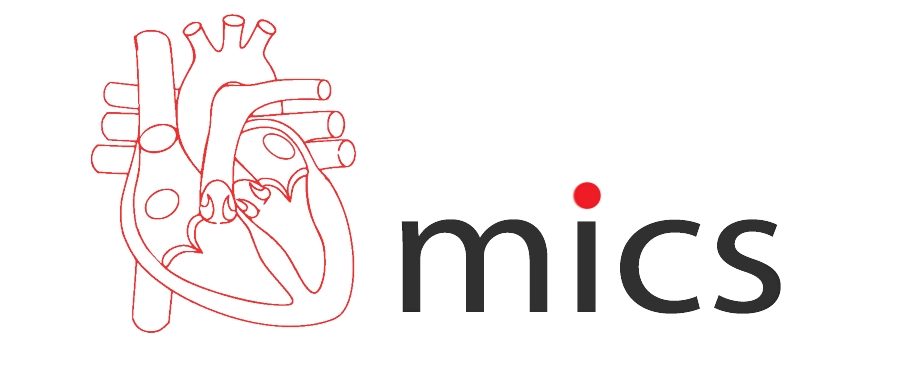Minimally Invasive Heart Surgery
Minimally invasive heart surgery is a surgical technique used to perform heart surgeries through smaller incisions compared to traditional open-heart surgery. It involves making small incisions in the chest, between the ribs or under the breastbone, to access the heart. The surgeon then uses specialized instruments and a tiny camera to perform the surgery with greater precision and control. The use of advanced imaging technology allows the surgeon to see the heart more clearly during the procedure. Minimally invasive heart surgery can be used for a variety of heart conditions, including valve repair or replacement, atrial septal defect (ASD) repair, and coronary artery bypass grafting (CABG) surgery. This technique offers numerous benefits, including less pain, smaller scars, reduced hospital stays, and faster recovery times.
Types of Minimally Invasive Heart Surgery
There are several types of minimally invasive heart surgeries, each designed to treat specific heart conditions. Some of the most common types of minimally invasive heart surgery include:
- Minimally Invasive Valve Surgery: Minimally Invasive Valve Surgery technique is used to repair or replace heart valves without the need for a large chest incision.
- Minimally Invasive Coronary Artery Bypass Grafting (CABG) Surgery: Minimally Invasive CABG technique involves using smaller incisions to bypass blocked arteries and improve blood flow to the heart.
- Minimally Invasive Atrial Septal Defect (ASD) Repair: This technique is used to repair a hole in the wall between the heart’s upper chambers (atria) without the need for open-heart surgery.
- Minimally Invasive Maze Procedure: This technique is used to treat irregular heartbeats (arrhythmias) by creating scar tissue in the heart using a catheter, which redirects electrical signals to the proper pathways.
Your cardiac surgeon can determine which type of minimally invasive heart surgery is most appropriate for your specific heart condition.
What Is Minimally Invasive Heart Surgery Called?
Minimally invasive heart surgery is a general term used to describe a range of heart surgeries performed through small incisions rather than traditional open-heart surgery. The specific name of the minimally invasive heart surgery varies depending on the type of procedure being performed. For example, if the surgery involves repairing or replacing a heart valve, it may be referred to as minimally invasive valve surgery. If the surgery is used to bypass blocked arteries in the heart, it may be called minimally invasive coronary artery bypass grafting (CABG) surgery. Other common types of minimally invasive heart surgery include minimally invasive atrial septal defect (ASD) repair and minimally invasive maze procedure. Your cardiac surgeon can provide specific information on the type of minimally invasive heart surgery recommended for your individual needs.
Advantages of minimally invasive heart surgery
There are several advantages of Minimally invasive heart surgery offers over traditional open-heart surgery. These include smaller incisions, less pain, reduced risk of infection, shorter hospital stays, and faster recovery times. Patients who undergo minimally invasive heart surgery also typically experience less blood loss and scarring. Because the procedure is less invasive, patients may also be able to return to their normal activities more quickly than those who undergo open-heart surgery.
Reduced Risk of Infection
The reduced risk of infection in minimally invasive heart surgery is due to the smaller incisions made during the procedure. Smaller incisions mean less exposure of the heart to the environment, reducing the risk of contamination and infection. Additionally, because the procedure is less invasive, patients typically have shorter hospital stays, which also reduces the risk of infection.
Shorter Hospital Stays
Shorter hospital stays are possible during and after minimally invasive heart surgery due to the less invasive nature of the procedure. Because the surgery involves smaller incisions and less trauma to the body, patients typically experience less pain and require fewer pain medications. This allows them to recover more quickly and begin to resume normal activities sooner. Additionally, because the risk of complications and infections is lower with minimally invasive heart surgery, patients may be discharged from the hospital sooner, further reducing the length of their hospital stay.
Lower Blood Loss and Need for Blood Transfusions
Minimally invasive heart surgery is associated with lower blood loss and a reduced need for blood transfusions compared to traditional open-heart surgery. This is due to the use of smaller incisions, which results in less tissue damage and bleeding. Additionally, the advanced imaging technology used during the procedure allows the surgeon to visualize the heart with greater precision, which can lead to more targeted and precise surgical techniques. As a result, patients who undergo minimally invasive heart surgery typically experience less blood loss, which reduces the need for blood transfusions and promotes faster recovery.
Lower Risk of Respiratory Complications
Minimally invasive heart surgery is associated with a lower risk of respiratory complications during and after the procedure. This is because the surgery is less traumatic than traditional open-heart surgery, which can result in less inflammation and damage to the lungs. Additionally, the smaller incisions used during minimally invasive heart surgery result in less pain and discomfort, which can help patients breathe more easily and effectively. Patients who undergo minimally invasive heart surgery also tend to have shorter hospital stays, which further reduces the risk of respiratory complications such as pneumonia. Overall, minimally invasive heart surgery offers several benefits over traditional open-heart surgery, including a lower risk of respiratory complications.
Improved Cosmetic Outcomes
Minimally invasive heart surgery offers improved cosmetic outcomes compared to traditional open-heart surgery. Because the procedure involves smaller incisions, there is less scarring and patients may experience less pain and discomfort after the surgery. Additionally, the smaller incisions are often located in areas that are less visible than those used in open-heart surgery, such as under the breastbone. This results in a more cosmetically pleasing outcome and may improve patients’ self-esteem and confidence. Overall, the improved cosmetic outcomes of minimally invasive heart surgery can be an important consideration for patients who are concerned about the physical appearance of their scars.
Potential for Better Long-term Outcomes
Minimally invasive heart surgery may offer the potential for better long-term outcomes compared to traditional open-heart surgery. Studies have shown that patients who undergo minimally invasive heart surgery experience fewer complications and a lower risk of infection than those who undergo open-heart surgery. This may translate into better long-term outcomes, such as improved quality of life and increased lifespan. Additionally, the less invasive nature of the procedure may result in less damage to the heart tissue, which may help to preserve heart function over time. While more research is needed to fully understand the long-term benefits of minimally invasive heart surgery, the potential for improved outcomes is promising.
Enhanced Patient Satisfaction
Minimally invasive heart surgery is associated with enhanced patient satisfaction during and after the procedure. This is because the procedure is less invasive than traditional open-heart surgery, which can result in less pain, scarring, and a shorter recovery time. Patients who undergo minimally invasive heart surgery may also experience fewer complications and a reduced risk of infection, which can further improve their satisfaction with the procedure. Additionally, because minimally invasive heart surgery is associated with better cosmetic outcomes, patients may feel more confident and satisfied with their appearance after the surgery. Overall, the enhanced patient satisfaction associated with minimally invasive heart surgery can have a positive impact on patient’s emotional and physical well-being.
Disadvantages of Minimally Invasive Heart Surgery
While minimally invasive heart surgery offers several advantages, there are also some potential disadvantages to consider. One of the main disadvantages is that the procedure may be more technically challenging than traditional open-heart surgery, which requires highly skilled surgeons and specialized equipment. Additionally, not all patients are good candidates for minimally invasive heart surgery, as the procedure may not be suitable for patients with certain types of heart disease. Finally, minimally invasive heart surgery may be more expensive than traditional open-heart surgery, which can be a barrier for some patients. Despite these disadvantages, minimally invasive heart surgery remains a promising option for many patients, and ongoing research is exploring new techniques to further improve outcomes and reduce potential risks.
Need for Specialized Training and Experience
Minimally invasive heart surgery requires specialized training and experience for surgeons due to the technical demands of the procedure. This may limit the availability of the procedure and require patients to seek out specialized centres or surgeons with experience in minimally invasive techniques.
Higher Cost
Minimally invasive heart surgery can be more expensive than traditional open-heart surgery due to the specialized equipment and expertise required to perform the procedure. This can limit access to the procedure for some patients and increase healthcare costs.
Longer Operating Times
Minimally invasive heart surgery can sometimes take longer to perform than traditional open-heart surgery due to the increased technical demands of the procedure, which may result in longer operating times.
Reduced Options for Complex Cases
Minimally invasive heart surgery may not be suitable for all cases, particularly complex cases that require extensive surgical intervention. In such cases, traditional open-heart surgery may be a better option. This highlights the importance of careful patient selection and evaluation by experienced heart surgeons.
Limited Availability in Some Regions
Minimally invasive heart surgery may not be widely available in some regions due to the need for specialized equipment and training. This can limit access to the procedure for some patients.
Patients Requiring Multiple Procedures
Minimally invasive heart surgery might not be done in cases requiring multiple procedures like Multi vessel bypass with Aortic Valve Replacement or Mitral Valve Replacement or Double Valve Replacement. This may be a limitation in certain cases that require more extensive surgical intervention.
Reduced Ability to Perform Some Types of Repairs
Minimally invasive heart surgery may not be suitable for some types of repairs, particularly those that require extensive surgical intervention or access to multiple areas of the heart. In such cases, traditional open-heart surgery may be a better option.
Need for Additional Equipment and Instrumentation
Minimally invasive heart surgery requires specialized equipment and instrumentation, which can be expensive and may not be available at all medical centres. This can limit access to the procedure for some patients.
What Are the Risks or Complications of Minimally Invasive Heart Surgery?
Minimally invasive heart surgery carries some risks and potential complications, although they are generally less frequent than traditional open-heart surgery. These may include bleeding, infection, damage to surrounding organs or tissues, blood clots, and adverse reactions to anaesthesia. Additionally, there may be risks associated with the use of specialized equipment and instrumentation with improper training, including damage to blood vessels or other structures. However, with an experienced hand, the overall risks and complications associated with minimally invasive heart surgery are generally lower than those associated with traditional open-heart surgery.
What Is the Success Rate of Minimally Invasive Heart Surgery?
The success rate of minimally invasive heart surgery varies depending on the specific procedure and the patient’s individual circumstances. Generally, the success rate is very high, with many patients experiencing significant improvements in their cardiac function and quality of life. However, as with any surgical procedure, there are potential risks and complications, so it is important to discuss the potential benefits and risks with your healthcare provider.
How Long Does It Take to Recover from Minimally Invasive Heart Surgery?
Recovery time after minimally invasive heart surgery varies depending on the specific procedure and the patient’s individual health. In general, patients can expect to spend a few days in the hospital, followed by a period of at-home recovery lasting several weeks. During this time, patients may experience some pain and discomfort, but with proper care and follow-up, most patients can expect to return to their normal activities within several weeks to a few months. Your healthcare provider can give you a more accurate estimate of your individual recovery timeline based on your specific case.


